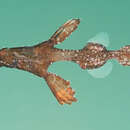Brief Summary
provided by EOL authors
The ghost pipefishes (family Solenostomidae) are skin-brooding fishes related to the true pipefishes and seahorses (family Syngnathidae) (skin-brooding involves the attachment of developing eggs to the body surface of a parent). They are found only in the Indian and Pacific Oceans, inhabiting shallow tropical waters associated with rocky crystalline reefs and vegetation. Unlike syngnathids, in which males brood the eggs, ghost pipefish embryos develop within a brood sac formed by the pelvic fins of the female. Wetzel and Wourms (1995) review the anatomy, physiology, and evolution of solenostomid reproductive behavior. According to Kawahara et al. (2008), evidence from phylogenetic analysis of whole mitochondrial genomes indicates that the Solenomostidae form the sister group to Syngnathidae, with the sea moths (family Pegasidae) sister to this pair of lineages. . The family Solenostomidae includes a single genus (Solenostomus) with four or five currently recognized species: S. paradoxus, S. armatus, S. cyanopterus, S. halimeda, and possibly S. leptosoma (Orr et al. 2002; Nelson 2006). The distribution of the genus ranges from the Red Sea and South Africa east to the Maldives, Indonesia, China, southern Japan, Papua New Guinea, and the Marshall Islands and Fiji. Ghost pipefishes are often associated with the marine plant Halophila or the seaweeds Cystoseira or Sargassum and are believed to be limited to depths between ~30 to 40 m, although pairs of S. cyanopterus have been reported from just 3 m. Ghost pipefish look like truncated true pipefish. They have laterally compressed bodies, two separate dorsal fins, a large anal fin that is similar in shape to the second dorsal fin, and a large ventral fin. The head resembles that of true pipefishes, but in Solenostomus the head represents over a third of the total body length, whereas in syngnathid pipefishes the head accounts for at most an eighth of total length. Solenostomids lack scales, but instead develop a dermal skeleton of plates. In females, the ventral fin is enlarged and continuous with the ventral body surface to form a pouch or brood sac for holding eggs (possibly as many as 350). (Fishelson 1966; Orr and Fritzsche 1993; Wetzel and Wourms 1995 and references therein; Orr et al. 2002) External skin brooding has evolved independently in several groups of fishes. Among these, Solenostomus and certain South American catfishes share the development of cotylephores, which are special sites for the attachment of developing embryos (within the fused pelvic fins of Solenostomus and on the ventral surface of Platystacus catfishes and other aspredinid cattfishes of the tribe Aspredini). Cotylephores are transient outgrowths of tissue that occur only on brooding fish. Wetzel et al. (1997) analyze this striking example of convergent evolution. Ghost pipefishes are ambush predators. At birth, juveniles must immediately find suitable shelter to begin feeding and hide from predators. (Werzel and Wourms 1995) The Robust Ghost Pipefish (Solenostomus cyanopterus) has a relatively deep snout; a deep, short caudal peduncle, with a mode of eight caudal peduncle plates; an absence of abdominal spinules; and males with premaxillary spines. It is distributed from South Africa and the Red Sea to the Maldives, Indonesia, southern Japan, Guam, New Guinea, Australia, and Fiji. Orr and Fritzsche (1993) and Orr et al. (2002) should be consulted for detailed descriptions of the morphology and geographic distributions of the recognized ghost pipefish species.

